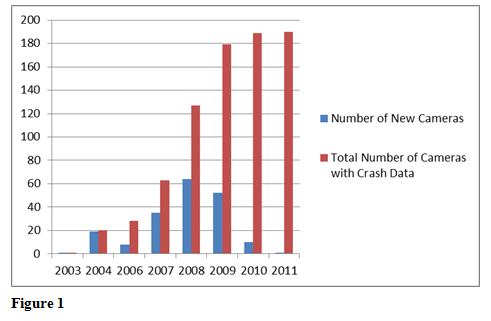
By Adam Rouse
Anyone who has driven in a red-light camera city long enough has either witnessed the flash of a strobe light documenting another motorist being photographed for an alleged red light violation or experienced the feeling of dread and annoyance of seeing the strobe flash in his or her own rear-view mirror. City officials and red light camera vendors love to talk about how the cameras are all about safety and reducing traffic collisions. Opponents of traffic cameras will often state that it is all about the money – revenue generated for both the private companies and the local government. The truth, it seems, may lie somewhere in the middle.
It isn’t difficult to believe that cities like Chicago, which are facing tough budget decisions and looming debt, would turn to new sources of revenue to boost their income. Red-light cameras can be very lucrative for big cities especially in California where drivers pay a massive $480 fine for every violation. Chicago, which leads the nation in the total number of red-light camera enforced intersections, issues administrative fines for red-light camera citations in the amount of $100 per incident generating over $500 million in revenue for the City thus far. Chicago quietly changed its policy of issuing citations when the yellow-light interval was greater or equal to 3.0 seconds to issuing citations when the yellow-light interval was greater or equal to 2.9 seconds. While one tenth of a second may not seem an appreciable amount, consider that this change in policy generated an additional $7.7 million for Chicago in the just over half a year it was in effect.
The Chicago Inspector General’s office concludes that the City did not deliberately alter yellow-light times to generate tickets and the variances in yellow-light timing stemmed from power fluctuations in the traffic signals that were within the acceptable variance. The report from the Inspector General includes a document from PEEK Traffic documenting the acceptable actual display time for a yellow-light programmed to last 3.0 seconds is anywhere from 3.12 seconds to 2.89 seconds based on the fluctuation of power cycles in the timing circuits. There are reports that when independently tested, yellow-lights in Chicago can fall outside of the acceptable times noted in the Inspector General’s report. This video, produced by Barnet Fagel, an expert witness in many red light camera cases in Chicago, illustrates the issues with yellow-light times at the intersections generating the most income for Chicago. All of the intersections were timed with yellow-lights lasting less than 3 seconds, and some fell outside of the acceptable range mentioned above.
As questionable as the yellow-light times are in Chicago, municipalities in Florida were caught deliberately reducing their yellow-light durations after a change in language in state law allowed for a shorter yellow-light duration. Florida law bases the yellow-light duration minimums strictly on the speed limit of the streets that make up the intersection. Florida does not require the US DOT recommended traffic studies to determine the 85th percentile speed at which drivers enter the intersection nor the extra half-second interval addition for intersections with a high percentage of use by elderly drivers or trucks with loads—both of which require either extra time or distance to come to a complete stop. The result was predictably higher revenue from fines and outrage from Floridians who felt they were duped and unfairly ticketed.
Shortening yellow-light times to the minimum limits may be perfect for lining governmental coffers, but does this practice work for reducing accidents at intersections where red-lights are enforced by automated camera systems? The City of Chicago certainly wants people to think so; according to the data it released claiming that crashes at camera enforced intersections were down by 33% over a 7 year period since the first cameras were installed in 2005. At first glance a 33% reduction in crashes seems to suggest that the cameras really are increasing safety in Chicago.
The problem is the misleading statistical data and methodology that the City of Chicago uses to draw the conclusion that cameras are increasing safety. When looking at the data, every intersection with a camera is included in the comparison of number of crashes in 2005 to the number of crashes in 2012. Figure 1 shows when all the cameras used to report crash statistics were actually installed. The vast majority of the intersections used by Chicago in its data did not have cameras installed in 2005 thus it is entirely possible that the intersections with cameras installed between 2007 and 2009 could have been trending down before the cameras were ever installed. Another huge problem with Chicago’s so-called analysis is the lack of any control data. An independent study suggests that accident rates were falling generally during the same time period that Chicago analyzes in its report. Thus, there is no reliable way based on the data presented by the City of Chicago to infer any sort of causal link between the installation of red-light cameras and an increase in traffic safety at those intersections. With the data presented, it is difficult to draw even a correlative conclusion between the red-light cameras and increased traffic safety.
Improperly timing the yellow-light duration can lead to more collisions at an intersection because drivers do not have enough time to safely stop. The Federal Highway Administration (“FHWA” part of the U.S. Department of Transportation) partnered with traffic engineers and safety experts to create a method to determine safe yellow-light durations. The following formula is a result of the research performed to determine a safe yellow-light duration at intersections: yellow-light duration (in seconds) = t + (1.47 x V85 / 2d + 2Gg). This formula seems complicated until the constants are filled in and explained. The variable t will almost always be 1 because the average reaction time of a driver to a change of a traffic signal is 1 second. This variable should be increased in areas where it is known that drivers have a longer reaction time to changing signals. The V85 variable is the speed at which 85% of the traffic travels on the streets that comprise the intersection assuming that traffic is flowing in an unobstructed flow. This 85% speed may or may not be near the speed limit of the streets, and can only be determined by a properly executed traffic study. The average deceleration of a stopping vehicle is 10 ft/s2 and is the constant d in the equation. The last portion of the equation 2Gg deals with grades (up or down hill slope) at the intersection. Because most, if not all, intersections in Chicago have no significant grade and are relatively flat it is safe to assume that 2Gg will equal 0 in the flowing calculations. Thus, when simplified for Chicago intersections the formula becomes: yellow-light duration = 1 + (1.47 x V85 / 20).
Applying the formula to intersections in Chicago yields some very interesting results. Assuming that traffic is flowing through an intersection at the posted speed limit of 30mph then the yellow-light time would equal 1 + (1.47 x 30 / 20) or 3.2 seconds. Taking the variations in yellow-light duration produced by the variations in power supplied to signals noted in the PEEK report above, the actual time the yellow-light duration should be programmed for 3.33 seconds producing actual yellow light times of 3.20 to 3.44 seconds to be considered safe by the FHWA. For intersections where the traffic is flowing at an average approach speed of 35mph the yellow-light duration should be 3.57, or programmed for 3.69 seconds to produce yellow durations between 3.57 and 3.81 seconds. Based on the above formula and calculations the yellow-light durations are set below the correct safety standards recommended by the FHWA and traffic engineers.
Properly administered red-light cameras can have a positive effect on intersection safety provided that the crashes are caused by driver behavior that is able to be changed by enforcement measures. The FHWA notes that the best results are achieved by combing traffic engineering, driver education, and enforcement measures where needed. If Chicago was truly interested in improving traffic safety in the city perhaps the half-a-billion dollars collected from the red-light camera program thus far could be used to perform meaningful traffic studies to collect valid data and fund driver education programs to prevent red-light running and the associated crashes. Once Chicago traffic engineers had proper data and studies to work with they could adjust the yellow-light times to the applicable safe standards and implement other traffic engineering solutions that were designed to increase safety and not rely on red-light cameras that do little more than generate revenue for the city at the expense of its citizens.








